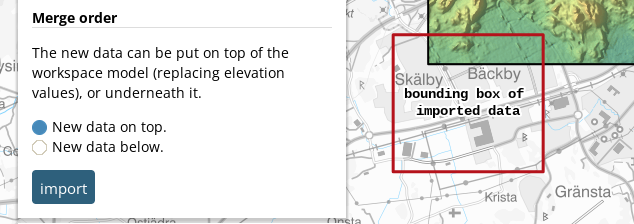-
Documentation
-
About
- Getting Started & Use Cases
- Support
-
What's New
- Simplified tools for designing with contour lines
- DynamicFlood: Organize and understand your computations
- Modelling stormwater networks in Scalgo Live
- National US high-resolution land cover map
- New functionality for CAD users!
- DynamicFlood: Cleaning up rain events and adding historical rains, now available in France
- National Polish high-resolution land cover map
- DynamicFlood now available in Great Britain
- Global contour maps now available
- Updated Swedish topsoil map
- Scalgo Live Global theme is updated with new elevation and land cover data
- Detailed culvert information in DynamicFlood
- No more Lantmäteriet fees for Swedish data
- Depth-dependent surface roughness (Manning) in DynamicFlood
- Detailed land cover map for all of Great Britain
- National French high-resolution land cover map
- Work with multiple features simultaneously in the canvas
- Spill points on flash flood map and depression map
- New surface roughness (Manning) parameters for DynamicFlood
- Workspace and Modelspace sharing updates
- Regionally varying rain in DynamicFlood Sweden
- Veden imeytyminen nyt osana rankkasadeanalyysejä
- Use Scalgo Live anywhere in the world
- DynamicFlood: Live model speed info and regionally-varying rain events
- Sea-level rise: Download building flooding information
- Detailed contour maps and editable buildings in Workspaces
- New in Modelspaces: Explore hydrodynamic simulations and visualise the dynamics of flow velocity
- National German high-resolution land cover map
- Specify basins and protrusions by drawing their outer boundary
- Simplified path features
- National Norwegian high-resolution land cover map
- Organise and communicate on a digital canvas
- New sidebar to help organize your analyses and queries
- Sliding contours
- Ny skyfallsanalys och en ännu bättre marktäckekarta
- New land cover map for Finland
- Depths in the depression map
- New Danish land cover map with more classes
- National Swedish High-Resolution Impervious Surface Mapping
- Watershed tool updated with even better descriptions of catchment characteristics
- National Flash Flood Map with Infiltration and Drainage for Denmark
- Add your own WMS layers to SCALGO Live
- Enriched building data in Denmark
- National hydrological corrections and Land Cover for Poland
- National hydrological corrections for Norway
- Updated Impervious Surface Mapping for Denmark
- National hydrological corrections and updated local data for Finland
- Fast and intuitive tools to work with infiltration and land use
- Improvements to vector imports and exports
- National Danish groundwater model
- New Sweden high-resolution model
- New powerful depression map and more analyses visualization options
- Introducing Modelspaces: Get your hydrodynamic models into SCALGO Live
- Use case videos
- Access a EA flood maps inside SCALGO Live
- Improved map export
- New powerful ways to edit the elevation model
- Better coloring of flooding layers and sea-level depth filtering
- National Danish High-Resolution Impervious Surface Mapping
- National access for local and regional organizations
- Simpler, more powerful downloads
- Customize Layer Transparency
- Hydrological corrections and new data in Sweden
- Improved export functionality
- Access a wide range of authorative data inside SCALGO Live
- Importing VASP data
- Measure gradients, undo edits, and Norway updates
- New terrain edit features, soil balance information and much more...
- Browse historical orthophotos in SCALGO Live
- Emergency planning with sea-level rise from national forecast data
- Detailed information about watershed composition
- Better styling of imported vector layers
- New Danish Elevation Model
- Work with gradients in the profile widget
- Flood risk screening from rivers and flow paths
- New workspace tool: Raise and lower terrain uniformly
- Importing LandXML TINs, LAS point clouds
- New model in Sweden
- Side slopes on workspace features
- Drag and drop enhancements
- Swedish contour maps
- Subsurface basins and sewage drains in workspaces
- New Interface
- Volume information for watersheds and flow paths
- New powerful tool for emergency response and coastal flood prevention
- Denmark: New flash flood map
- Sweden: Geodatasamverkan setting for Swedish users
- Import custom terrain models
- New Hydrological Corrections
- Elevation contours now available
- Download orthophotos as JPEG and PNG
- Subsurface structures in workspace
- Sea-levels in terrain profiles
- Updated orthophotos
- Models and analysis update
- User interface updates
- User interface updates
- GeoDanmark/FOT data, Matrikelkortet now available
- New flash flood map
- Download of risk polygons
- Updated orthophotos
- Nationwide hydrology on the new DHM/2015 model now available
- New flash flood map computation available with watershed download
- DHM/2015 variants and sea-levels now available nationwide
- DHM/2015 now available nationwide
- Hydrology on the new DHM/2015 model now available
- New DHM/2015 Model - now with buildings
- New DHM Model
- Watershed Tool
- Ad hoc layers
- Nationwide contour maps for all countries
- Single Sign-On
- Data Fees
- User Interface
- Canvas
- Analysis
- Workspaces
- Modelspaces
- Working with CAD data
- Core+ DynamicFlood
- Core+ NatureInsight
- Core+ PropertyResilience
- Streams and Flow
- Physical Properties
- Country Specific
-
About
Workspaces – Importing Terrain Data
SCALGO Live supports importing certain kinds of terrain data into workspaces. You can choose to create a new workspace based on such data, or incorporate the data into an existing workspace. Using an existing workspace is recommended in many cases, since it allows you to place the imported data in the context of a base model.
Do the following to incorporate locally stored terrain data into an existing workspace:
- Open the workspace dialog using the
button
- Click Import terrain model ....
- Click choose files to select the relevant file(s) (hold down Ctrl in the file-selector dialog to select multiple files). It is also possible to use a single ZIP file containing relevant data. See below for a list of supported file formats.
Alternatively, you can create a new workspace based on your locally stored terrain data by uploading the file(s) through the workspace creation tool.
Imported data should be georeferenced and have a spatial reference with a known EPSG code. If the spatial reference is not automatically detected, you can look up the EPSG code for your spatial reference system at for example epsg.io or spatialreference.org. Elevation values are always assumed to be in meters. See the manual entry on Coordinate Systems for more information.
If your terrain data comes from CAD software, please also consult our our recommendations for format and export workflow for the CAD software.
Extending and replacing elevation data
When importing terrain data partially overlapping existing data in a workspace, the workspace will be extended using the new data. For the part overlapping existing data, you can choose if the old or new data should be used by selecting the appropriate option in the "Merge order" submenu.

By first downloading data for e.g. a national elevation model, you can effectively extend your existing workspace, or revert previous imports that should be undone.
Raster data formats
The following raster terrain formats are supported:
- GeoTIFF (.tif)
- BIL/.hdr Labelled Raster (.bil + .hdr)
- HFA/Erdas Imagine (.img)
- Arc/Info ASCII Grid (.asc + .prj)
- Arc/Info Binary Grid (.adf, multiple files)
- USGS DEM (.dem)
- ASCII Gridded XYZ (.xyz)
- DFS2 (.dfs2): elevation data; other data can be visualized through modelspaces.
If not embedded, spatial references are also read from .aux.xml PAM files if provided.
When uploading multiple raster files, make sure they are using the same spatial reference and resolution (pixel sizes).
Note that nodata values in the raster are considered to be sea(-like) areas. When running sea-level rise analysis, these areas will be used as source of flooding, and when running flow analysis, these areas will consume any adjacent flow. When no nodata values exist, sea-level rise will consider the lowest cell as the flood source.
TIN (triangle) data formats
We support generating a workspace elevation model based on triangulated meshes. These can be exported from BIM/CAD software (such as Trimble Novapoint, AutoCAD Civil 3D and Bentley InRoads/PowerCivil). When importing a triangulated mesh, we find the highest (or lowest) point at each raster cell center and use this elevation in the workspace. The following TIN formats are supported:
- LandXML (.xml)
Note that only TIN data (LandXML Surfaces) in the file will be imported. - Shapefile (.shp + .shx + .prj)
Triangles should be represented as polygon features with 3D coordinates. - IFC (.ifc)
Note that only TIN data in the file will be imported. When exporting in IFC format from your CAD software, make sure to set "Level of Detail" to "High" - see e.g. our Revit tips.

Point cloud formats
When importing a point cloud, we first create a Delaunay triangulation (TIN) of the point cloud, and then, rasterize the triangulation as described above. The following point cloud formats are supported:
- LAS (.las, .laz)
If the point cloud is classified only points with class 2 ("ground") are used. - Shapefile (.shp + .shx + .dbf + .prj)
Using 3D point features or 2D point features with elevation stored in the first attribute. - XYZ (.xyz, .txt)
ASCII text files with one point per line, coordinates separated by spaces (example).